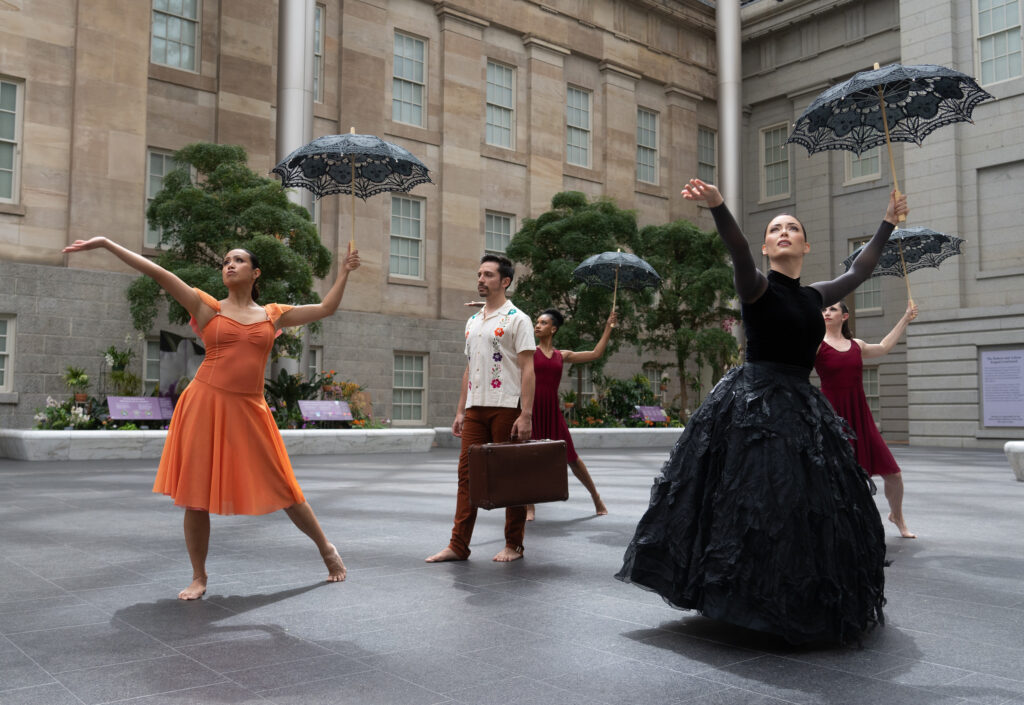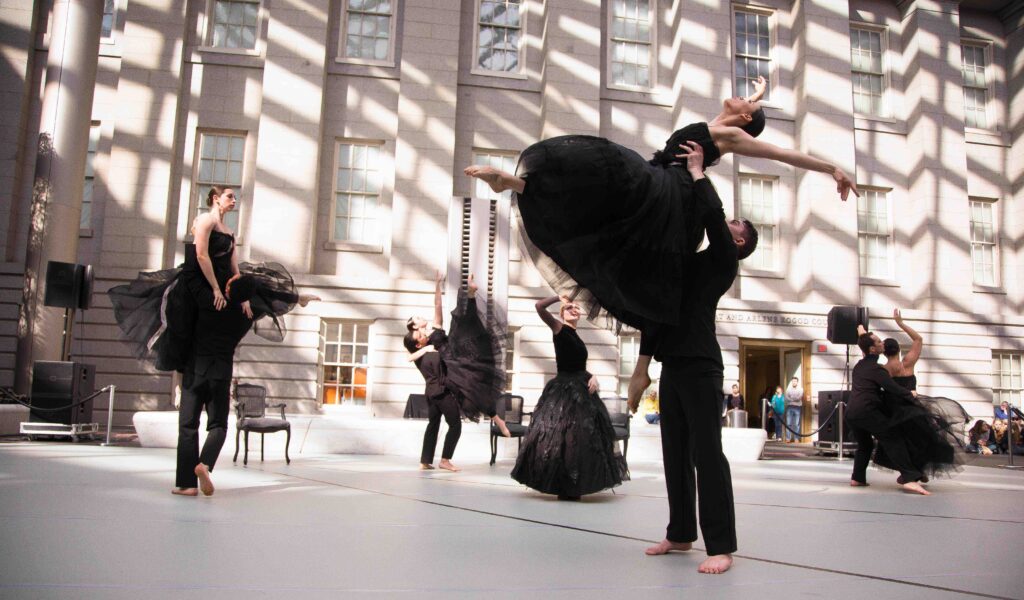Dance—expansive, ephemeral, distinctly alive—probably isn’t the first thing you think of when you picture a museum gallery’s austere, hushed vibe. “We’ve had a history since the Victorian era of going to museums and not being able to touch or engage with the artwork, walking through just as an observer, closed off from the consciousness of what you’re going to engage with,” says Dana Tai Soon Burgess, artistic director of his eponymous company and former choreographer in residence at the Smithsonian’s National Portrait Gallery in Washington, DC.
Recently, however, there’s been a noticeable uptick in dance projects in museum spaces. Though museums have long featured dance performances, today choreographers and companies are being given long-term residencies, exhibitions of their own with performance elements baked in, and site-specific installation pieces. Adding a kinesthetic element to works of fine art can offer museumgoers a uniquely three-dimensional experience—and museum spaces can offer dancemakers unique creative opportunities, as well.
“You Can’t Have Any Accidents”
That’s not to say that dancing in a museum is without its challenges. Those range from the obvious—like hard, slippery concrete or marble flooring—to the more nuanced, like taking security rotation schedules into consideration when planning performance times, so that the museum doesn’t incur extra security costs. Diana Movius, the National Portrait Gallery’s current choreographer in residence, addressed the issue of flooring for her contemporary ballet company by renting a portable sprung floor from a local flooring company and bringing marley from her studio. But she still depends on the dancers and their partners, when available, to help roll out, tape, and clean the marley.
Basic structural elements of a museum space can be obstacles too, though occasionally those obstacles transform into new creative possibilities. When creating his work Landscapes this past summer for the Noguchi Museum, Burgess had to contend with a wall in the center of an otherwise comparatively open indoor-outdoor gallery. His solution was to create a dance that circled that central wall. “No matter your vantage point, the [piece’s] cycle would come past you during its 30 minutes,” he says.
Burgess’ dancers simultaneously had to navigate several Noguchi sculptures in the space, a frequent challenge for museum performers. Francesca Harper, who had a work commissioned by the Metropolitan Museum of Art in 2015, remembers how hyper-aware of the art she needed to be while performing. “You’re at the Met, and there’s the Temple of Dendur—oh, my gosh!” she says. “You have to be careful you don’t fall. You can’t have any accidents.”

“People Walk in and Think, What’s Going On?”
Harper, who now is the artistic director of Ailey II—and an integral part of the current “Edges of Ailey” exhibit at the Whitney Museum in New York City, celebrating the life and dances of Alvin Ailey—believes that museum dance performance breaks the fourth wall in an exciting way. The dancers become companions to the audience members, she says, rather than simply performers.

of American Art.
That companionship lasts beyond the final bow, too. “In a traditional theatrical dance space, the stage is dark before you arrive and after you leave,” says Smita Sen, whose new exhibition at the Museum of Contemporary Art in North Miami will include a live performance by Sen. “Interactions with an audience are demarcated in really finite terms.” But in a museum space, the terms are less finite, and the interactions more intimate, as viewers wander in and out of the performance environment.
Movius has had equally memorable post-show interactions, and prizes the immediacy and rawness of feedback she receives after a piece is performed in a museum. “People will approach me and suggest new collaborations or places they’d like to see it performed,” says Movius, whose works often take on environmental justice themes. “I’ve had audience members come up to me and say, ‘Your piece brought me to tears.’ Students will come over and say, ‘I was here for my environmental science class, and I have a question for you.’ ”
Because a museum’s audience is typically different from a strictly dance-performance audience, both choreographer and museum can benefit from these kinds of collaborations. Movius, for example, is excited to offer a free performance with the National Portrait Gallery’s sizable reach and under their branding. “To not have to charge a ticket price and have the Smithsonian be the one organizing the shows has been energizing for me as a choreographer,” she says.
A dance performance, meanwhile, activates the museum space in a wildly different—and exciting—way. “People walk in, and there are all these dancers here. They think, What’s going on?” says Burgess. He thinks the future of dance lies in this kind of unexpected exposure. “For dance to continue to grow its audience and really survive, it can’t become so myopic that performances are just for the dance community,” he says.

“I Don’t Need to Limit My Practice”
The most fruitful museum-dance opportunities share a common denominator: thoughtful partnership between the dance artist and the museum’s curators or research team. For Burgess, one of the most thrilling parts of his residency at the National Portrait Gallery was the conversations he had with curators and historians. “That helped guide and inform me about the artist, the art work, as I’m doing my own research,” he says.
Sen has found both freedom and support in museum environments. “I’m very fortunate to have been given permission by the museums and institutions I’ve worked with to activate and engage the space fully and completely,” says Sen. “I don’t need to limit my practice as a performer and artist.”

“I Admire Museum Spaces for Looking Inward”
What’s behind the recent surge of dance in museums? Smita Sen believes that dance artists today might be more likely to seek out unconventional performance environments, thanks to a recent trend in some choreographers’ work toward introspection and the theoretical. “There’s an openness to share that in different spaces,” she says.
Dana Tai Soon Burgess thinks a generational shift among museum employees could also be expanding the idea of what kind of work should be presented. “Museum administrators understand that in order to fulfill their mission, they need to consider different ways of creating programming,” he says.
Francesca Harper credits the trend to the post–George Floyd era, and the push by museums to bring historically underrepresented voices into major cultural institutions. “People are asking for accountability around equality and really calling out appropriation,” says Harper. “I admire museum spaces for looking inward—cultural bias and unconscious bias are starting to get examined.”

